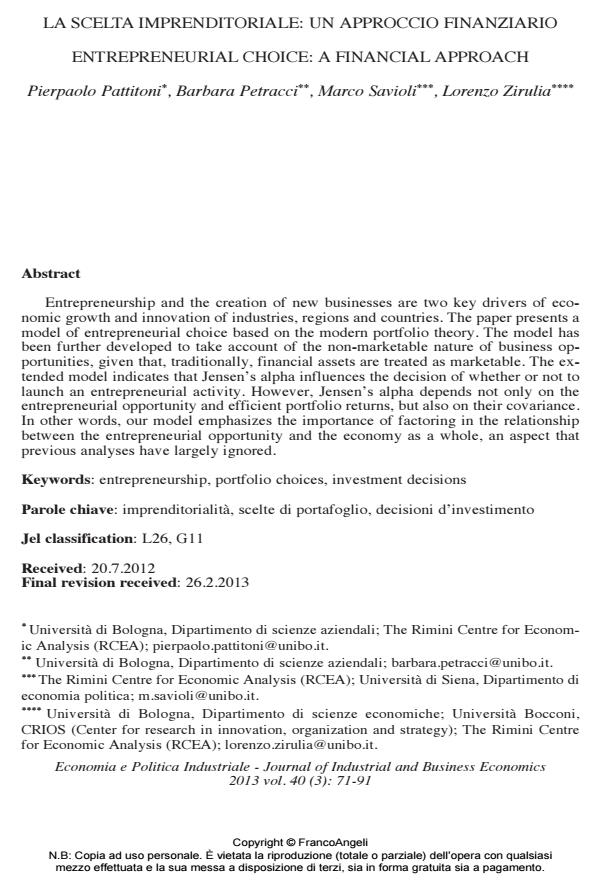Entrepreneurial choice: a financial approach
Journal title ECONOMIA E POLITICA INDUSTRIALE
Author/s Pierpaolo Pattitoni, Barbara Petracci, Marco Savioli, Lorenza Zirulia
Publishing Year 2013 Issue 2013/3
Language Italian Pages 21 P. 71-91 File size 290 KB
DOI 10.3280/POLI2013-003003
DOI is like a bar code for intellectual property: to have more infomation
click here
Below, you can see the article first page
If you want to buy this article in PDF format, you can do it, following the instructions to buy download credits

FrancoAngeli is member of Publishers International Linking Association, Inc (PILA), a not-for-profit association which run the CrossRef service enabling links to and from online scholarly content.
Entrepreneurship and the creation of new businesses are two key drivers of economic growth and innovation of industries, regions and countries. The paper presents a model of entrepreneurial choice based on the modern portfolio theory. The model has been further developed to take account of the non-marketable nature of business opportunities, given that, traditionally, financial assets are treated as marketable. The extended model indicates that Jensen’s alpha influences the decision of whether or not to launch an entrepreneurial activity. However, Jensen’s alpha depends not only on the entrepreneurial opportunity and efficient portfolio returns, but also on their covariance. In other words, our model emphasizes the importance of factoring in the relationship between the entrepreneurial opportunity and the economy as a whole, an aspect that previous analyses have largely ignored.
Keywords: Entrepreneurship, portfolio choices, investment decisions
Jel codes: L26, G11
- Kihlstrom R.E., Laffont J.J. 1982. A competitive entrepreneurial model of stock market, in McCall J.J. (ed.) The Economics of Information and Uncertainty. The University of Chicago Press: Chicago.
- Knight F. 1921. Risk, Uncertainty and Profit. houghton-Migfllin: Boston.
- Koellinger P.D., Thurik A.R. 2012. Entrepreneurship and the business cycle. The Review of Economics and Statistics, 94 (4): 1143-1156. DOI: 10.1162/REST_a_00224
- Lowe R.A., Ziedonis A.A. 2006. Overoptimism and the performance of entrepreneurial firms. Management Science, 52 (2): 173-186.
- Lucas R.E. 1978. On the size distribution of business firms. Bell Journal of Economics, 9 (2): 508-523.
- Markowitz h. 1952. Portfolio selection. Journal of Finance, 7 (1): 77-91, DOI: 10.1111/j.1540-6261.1952.tb01525.x
- Markowitz h. 1959. Portfolio Selection: Efficient Diversification of Investments. Wiley: New York.
- Moore D.A., healy P.J. 2008. The trouble with overconfidence. Psychological Review, 112 (2): 502-517, DOI: 10.1037/0033-295X.115.2.502
- Müller E. 2008. how does owners’ exposure to idiosyncratic risk influence the capital structure of private companies?. Journal of Empirical Finance, 150 (2): 185-198, DOI: 10.1016/j.jempfin.2007.09.002
- Parker S.C. 2009. The Economics of Entrepreneurship. Cambridge University Press: Cambridge (UK).
- Pattitoni P., Petracci B., Spisni M. 2009. Il costo del capitale per l’imprenditore: una verifica empirica per l’Italia. Banca Impresa e Societa, 28 (3): 443-471, DOI: 10.1435/31016:y:2009:i:3:p:443-472
- Pattitoni P., Savioli M. 2011. Investment choices: indivisible non-marketable assets and suboptimal solutions. Economic Modelling, 28 (6): 2387-2394, DOI: 10.1016/j.econmod.2011.06.027
- Pattitoni P., Petracci B., Potì V., Spisni M. 2013. Cost of entrepreneurial capital and under-diversification: a European Mediterranean small medium businesses perspective. Research in International Business and Finance, 27 (1): 12-27, DOI: 10.1016/j.ribaf.2012.04.004
- Rampini A. 2004. Entrepreneurial activity, risk, and the business cycle. Journal of Monetary Economics, 51 (3): 555-573, DOI: 10.1016/j.jmoneco.2003.06.003
- Santarelli E., Vivarelli M. 2007. Entrepreneurship and the process of firms’ entry, survival and growth. Industrial and Corporate Change, 16 (3): 455-488, DOI: 10.1093/icc/dtm010
- Schumpeter J.A. 1934. The Theory of Economic Development. Harvard University Press: Cambridge (Mass.).
- Shane S., Venkataraman S. 2000. The promise of entrepreneurship as a field of research. Academy of Management Review, 25 (1): 217-226, DOI: 10.5465/AMR.2000.2791611
- Shefrin h. 2007. Finanza aziendale comportamentale: decisioni per creare valore. Apogeo: Milano.
- Svenson O. 1981. Are we all less risky and more skillful than our fellow drivers?. Acta Psychologica, 47 (2): 143-148, DOI: 10.1016/0001-6918(81)90005-6
- Tobin J. 1958. Liquidity preference as behavior towards risk. Review of Economic Studies, 250 (2): 65-86.
- Van Praag C.M. 1999. Some classic views on entrepreneurship. De Economist, 147 (3): 311-335.
- Weinstein N.D. 1980. Unrealistic optimism about future life events. Journal of Personality and Social Psychology, 39 (5): 806-820, DOI: 10.1037/0022-3514.39.5.806
- Williams J.T. 1978. Risk, human capital, and the investor’s portfolio. Journal of Business, 510 (1): 65-89.
- Alvarez S.A., Parker S. 2009. Emerging firms and the allocation of control rights: a Bayesian approach. Academy of Management Review, 34 (2): 209-227, DOI: 10.5465/AMR.2009.36982616
- Audretsch D.B., Keilbach M.C., Lehmann E.E. 2006. Entrepreneurship and Economic Growth. Oxford University Press: New York.
- Camerer C., Lovallo D. 1999. Overconfidence and excess entry: an experimental approach. American Economic Review, 89 (1): 306-318.
- Congregado E., Golpe A.A., Parker S. 2012. The dynamics of entrepreneurship: hysteresis, business cycles and governments. Empirical Economics, 43 (3): 1239-126, DOI: 10.1007/s00181-011-0516-6
- Elton E.J., Gruber M.J., Brown S.J., Goetzmann W.N. 2009. Modern Portfolio Theory and Investment Analysis. J. Wiley and Sons: New York.
- Geroski P.A. 1995. What do we know about entry?. International Journal of Industrial Organization, 13 (4): 450-456, DOI: 10.1016/0167-7187(95)00498-X
- Kerins F., Smith J.K., Smith R. 2004. Opportunity cost of capital for venture capital investors and entrepreneurs. Journal of Financial and Quantitative Analysis, 390 (2): 385-405.
- Kihlstrom R.E., Laffont J.J. 1979. A general equilibrium entrepreneurial theory of firm formation based on risk aversion. Journal of Political Economy, 87 (4): 719-748.
- Strategic orientation of hotels: Evidence from a contingent approach Manuela Presutti, Marco Savioli, Vincenza Odorici, in Tourism Economics /2020 pp.1212
DOI: 10.1177/1354816619868886 - Determinants of profitability in the EU-15 area Pierpaolo Pattitoni, Barbara Petracci, Massimo Spisni, in Applied Financial Economics /2014 pp.763
DOI: 10.1080/09603107.2014.904488 - Do overconfident and over‐optimistic entrepreneurs invest too much in their companies? Theory and evidence from Italian SMEs Enrico Maria Cervellati, Pierpaolo Pattitoni, Marco Savioli, in Strategic Entrepreneurship Journal /2022 pp.769
DOI: 10.1002/sej.1421
Pierpaolo Pattitoni, Barbara Petracci, Marco Savioli, Lorenza Zirulia, La scelta imprenditoriale: un approccio finanziario in "ECONOMIA E POLITICA INDUSTRIALE " 3/2013, pp 71-91, DOI: 10.3280/POLI2013-003003